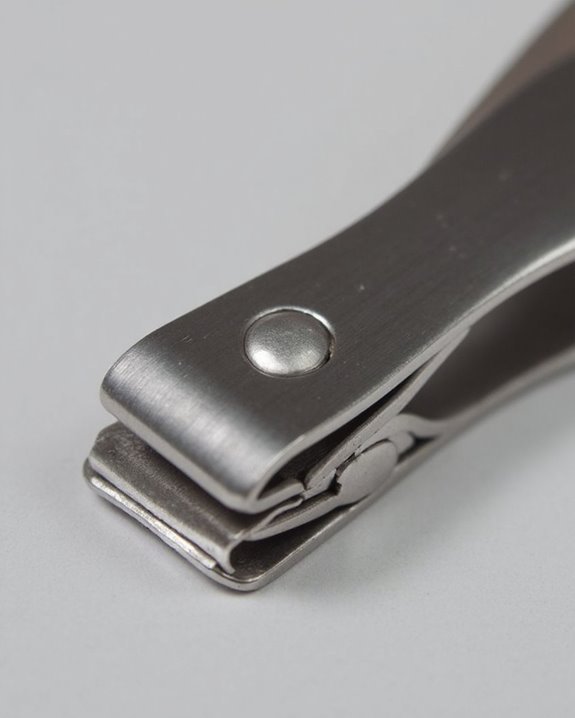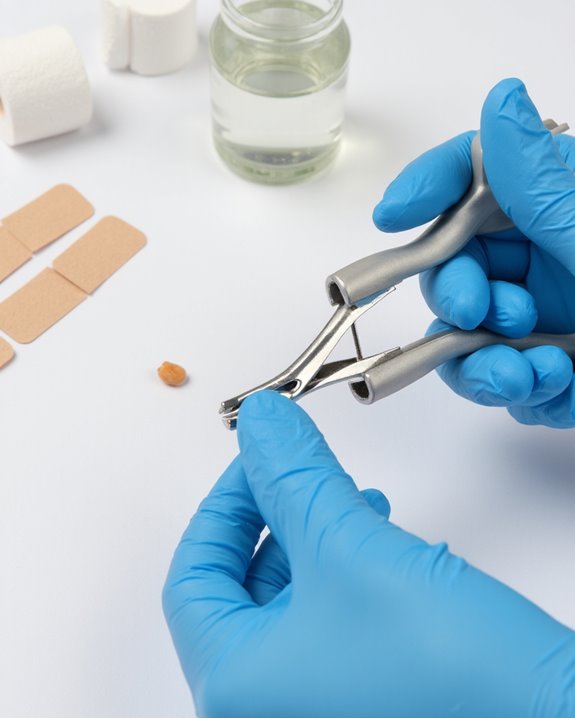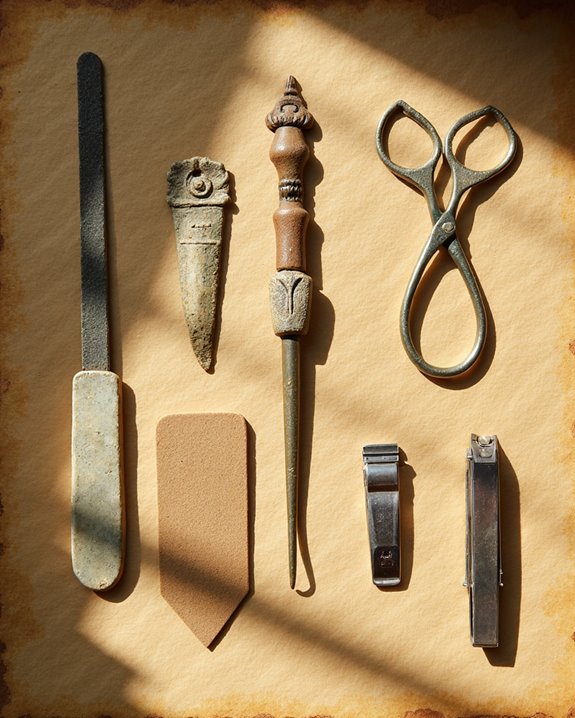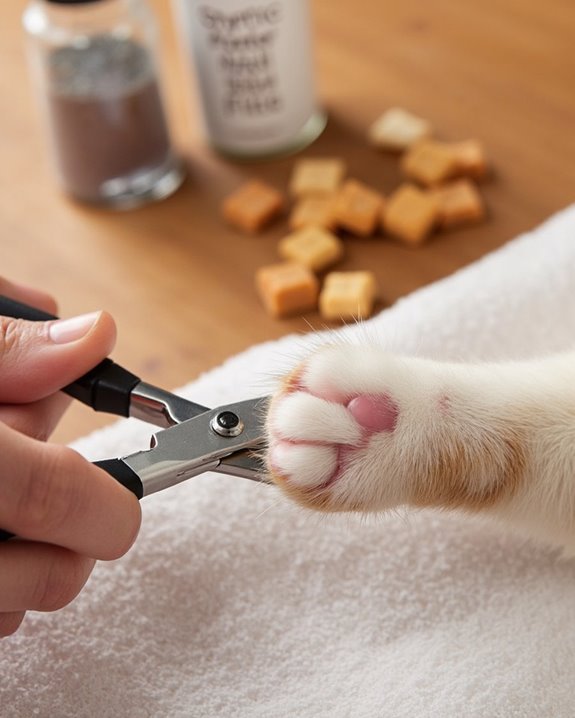To use guillotine dog nail clippers effectively, I recommend following seven key steps: gather proper tools, position your dog comfortably, identify the quick (pink area in light nails), hold the clipper perpendicular to the nail, insert nail through the opening, make swift clean cuts, and reward your pet immediately. For dark nails, make small, incremental cuts to avoid hitting blood vessels. Keep styptic powder nearby for accidents. The following detailed steps will transform nail trimming from a stressful chore into a manageable routine.
Key Takeaways
- Select guillotine clippers that fit comfortably in your palm with smooth blade movement and adjustable controls.
- Position the clipper perpendicular to the nail with the blade moving from bottom to top for clean cuts.
- Place only the nail tip through the stationary ring, staying 2mm away from the quick to prevent bleeding.
- Make small incremental cuts, especially for dark nails, while watching for the grayish-pink oval indicating the quick.
- Reward your dog with treats immediately after each successful nail trim to build positive associations.
Preparing Your Dog and Nail Clipping Tools
Gather all your necessary tools before attempting to trim your dog’s nails, as proper preparation is critical for a successful and stress-free experience. I always test my guillotine nail clippers several times without my dog present, ensuring they’re sharp and the blade moves smoothly. The clippers should fit comfortably in your palm, with your fingers positioned to squeeze effectively. Using adjustable speed controls can help tailor the trimming process to your dog’s nail type and reduce the risk of accidents. Have treats ready to reward your dog, styptic powder to stop bleeding if you accidentally cut the quick, and consider a muzzle for anxious pets. I’ve found that proper restraint techniques, such as positioning my dog’s paw firmly but gently, minimize movement during trimming. Always check that your dog nail trimmers have a properly adjusted guard to prevent cutting too deeply, which creates a safer experience for both you and your pet.
Properly Restraining Your Dog for Safe Trimming
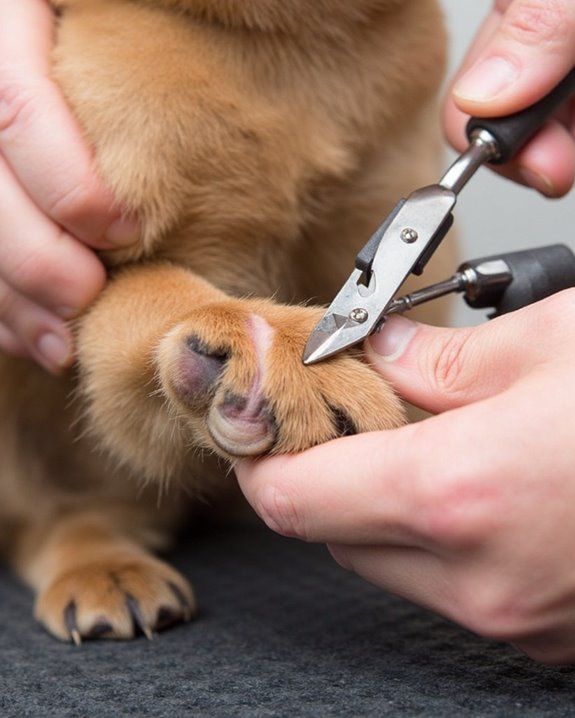
While many dogs naturally feel anxious during nail trimming, proper restraint techniques can greatly reduce stress and prevent injuries. I’ve found that draping my arms and upper body over my dog provides effective control during nail trimming sessions, especially for wiggly pets. When cutting front claws, I use my left forearm to apply a little pressure over my dog’s neck, preventing sudden head movements that could lead to accidents.
For particularly active dogs, I recommend laying them on their side for better stability during the Dog Grooming process. With cooperative pets, positioning them on your lap or a grooming table works well, starting with minimal restraint. Remember, the goal of restraining your dog during trimming your dog’s nails isn’t to frighten them but to guarantee both safety and precision.
Identifying the Quick to Prevent Bleeding
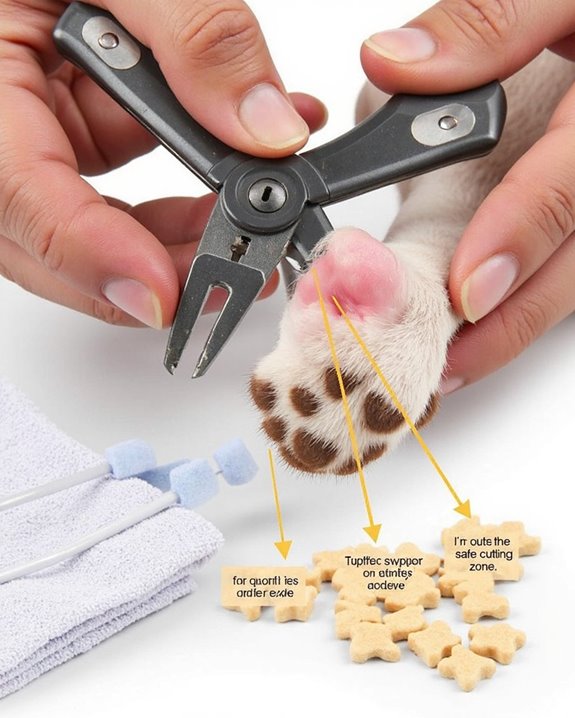
Before attempting to trim your dog’s nails with guillotine clippers, you’ll need to identify the quick—a sensitive area containing blood vessels and nerves that runs through the nail’s center. For dogs with lighter nails, this appears as a pink area inside the nail, making it easier to position your guillotine type clippers safely away from it.
With black nails, I recommend examining the underside of the nail to distinguish between the hard outer shell and softer quick. Make multiple small cuts at the tip of the nail, stopping when you see a grayish-pink oval on the cut surface—this indicates you’re about 2mm from the quick. If accidental bleeding occurs, apply styptic powder which quickly stops bleeding. Always maintain this safe distance, as guillotine clippers can make a clean cut that may inadvertently nick the quick if positioned incorrectly.
Positioning the Guillotine Clipper Correctly

Now that you’ve learned to identify the quick, proper positioning of your guillotine clipper becomes the next key step in safe nail trimming. I hold the clipper in my palm with my fingers positioned to squeeze the handles comfortably, maintaining a secure grip throughout the process.
When I trim my dog’s nails, I keep the clipper perpendicular to the nail, ensuring the cutting blade moves from bottom to top for a clean cut. I place the nail tip through the stationary ring, positioning the moving blade closest to me for maximum control. This horizontal-to-ground but perpendicular-to-nail orientation is essential to avoid cutting at improper angles that could damage the nail structure. The correct positioning creates a straight, precise trim while minimizing the risk of hitting the quick accidentally.
Making the Perfect Cut: Technique and Angle

The actual cutting technique with guillotine clippers determines whether your dog’s nail trimming experience will be smooth or stressful. I always hold the clippers perpendicular to the nail, making sure they’re upright in my palm for maximum stability as I prepare to cut the nail. When I clip my dog’s nails, I position the tip inside the stationary ring, which aligns perfectly with the nail’s natural curve.
To make the perfect cut, I squeeze the handle using the underside of my four fingers, keeping the blade closest to me for safety. I’m careful to make small cuts rather than taking off too much at once, which helps avoid hitting blood vessels in the quick. When trimming medium-sized dogs, I focus on maintaining a straight, controlled angle that guarantees a clean finish without any splintering.
Managing Accidents and Treating Cut Quicks

Even though I’m extremely careful when trimming my dog’s nails, accidents can happen when the guillotine blade catches the quick, causing bleeding and discomfort for my furry friend. To stop bleeding immediately, I keep styptic powder or cornstarch nearby during every nail-trimmed session, applying it directly to the affected nail while maintaining firm pressure for 1-2 minutes.
For dark nails where the quick is harder to see, I make small, incremental cuts, which makes it easier to cut without injuring the animal and causing pain. If bleeding persists beyond 5 minutes despite your efforts, contact your veterinarian right away. After treatment, I gently clean the area with a damp cloth and monitor for 10-15 minutes—these tips to help manage accidents will guarantee nail trimming remains a safe experience.
Rewarding Your Dog and Building Positive Associations
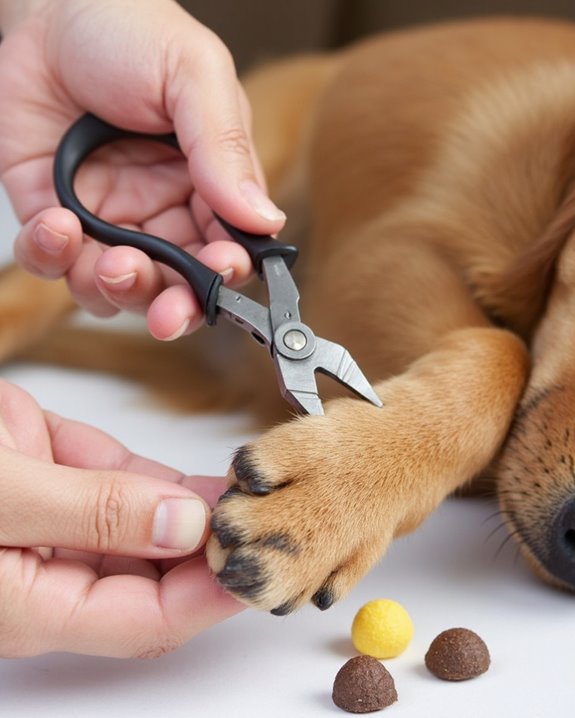
While managing accidents is an important safety aspect, creating pleasant memories around nail trimming is equally valuable for your dog’s long-term cooperation. When your nail clippers come out, make sure your family member feels they’re comfortable by immediately offering high-value treats after each session. This builds positive associations, similar to how a pair of scissors might initially seem threatening until your dog learns they’re harmless.
Start this conditioning process early, combining verbal praise with treats whenever your pup allows paw handling. Different types of rewards work well – some dogs respond best to food while others prefer play sessions after trimming. Track your progress systematically; most owners notice significant improvements within weeks. Remember, consistent positive reinforcement transforms an initially stressful experience into a bonding routine that strengthens trust, especially if they’re rewarded properly every time.
Frequently Asked Questions
How to Use the Guillotine Dog Nail Clipper?
I hold my dog gently, insert the nail into the opening, and squeeze firmly. For safety tips, I avoid the quick. Regular routine maintenance guarantees comfort techniques work well. Usage advice: practice proper hygiene practices between trimmings.
How Do You Cut a Dog’s Nails Step by Step?
Like a gentle sculptor, I trim my dog’s nails by preparing tools, establishing a grooming routine, holding the paw firmly, making small cuts safely, and providing post-trim care—offering health benefits and preventing injury for all breeds.
How to Use a Nail Cutter Step by Step?
I always handle my nail cutter carefully for human nails, using proper technique basics. I maintain my tools regularly, follow safety measures, and avoid errors by cutting straight across. Regular maintenance guarantees best performance.
Are Guillotine Nail Clippers Good for Dogs?
Like a knight’s sharp blade, guillotine clippers can be effective for my dog. Safety concerns vary by breed suitability. Pain factors are minimal if I’m careful. User reviews favor them over comparison tools despite some effectiveness debate.


